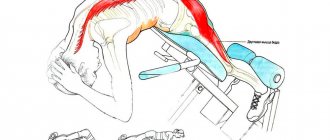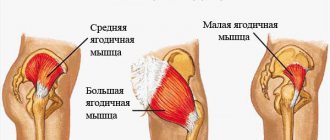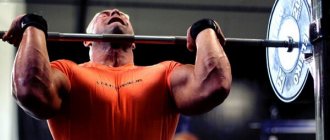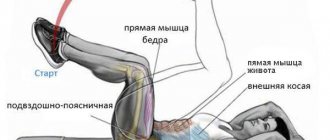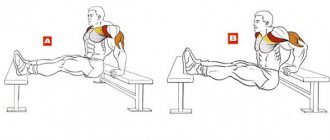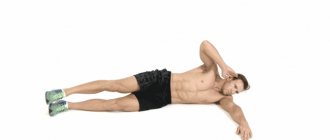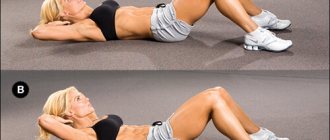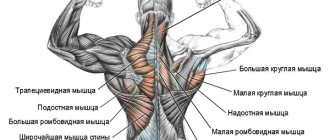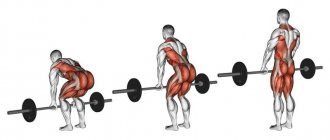Hyperextension is the most effective exercise that strengthens and develops the spinal muscles located in the lumbar region. This type of training is especially popular among women who want to reduce the size of their belly.
The purpose of the exercise is to train the biceps, semitendinosus and semimembranosus femoris muscles, as well as the gastrocnemius and gluteus maximus muscle groups. Hyperextension exercises are recommended for sedentary people and beginner athletes.
The exercise is contraindicated for people suffering from spinal diseases.
The effectiveness of the exercise is ensured by its regular and technically competent execution over a period of 3-4 weeks.
Classic hyperextension
Before starting the exercise, you need to set up the machine by installing the front rollers at the lumbar-femoral curve and placing the rear ones just above the Achilles tendon.
Then take the starting position by placing your feet under the lower bolsters and using them as a support for your legs and placing your back in the same horizontal line as your legs.
The main movement of the exercise is a smooth lowering and lifting of the body with bending of its lumbar region through the front training rollers. The lowering is performed with extremely tense gluteal muscles, and the beginning of the ascent is accompanied by a slight rounding of the back.
During the exercise, your arms are crossed on your chest. The angle of inclination of the body when lowering should be 60 degrees for experienced athletes and 30 for people who have recently started training.
Inhale while lowering, and exhale when returning to the starting position.
Purpose of the exercise
Hyperextension is a fairly simple exercise in technical execution, and its healing effect on the body is enormous.
The main goal of the movement is to develop back extension and form a supporting muscular corset for the spine.
When performing heavy basic exercises, the abdominal and lower back muscles act as the main stabilizers of the body, receiving a high load.
Strong lower back and abs are the key to injury prevention and the key to good sports results. Therefore, in all sports, special attention is paid to their development.
If athletes work out their lower back so as not to injure it during power loads, then ordinary gym goers come to work out to eliminate problems of the musculoskeletal system - with the presence of hernias, protrusions, etc.
The purpose of training is health-improving. Namely, the creation of a muscular corset of the back to reduce or completely eliminate pain.
Hyperextension at home
With a competent approach to organizing classes, hyperextension at home successfully competes with back-strengthening exercises performed in the gym. Some simple and effective ways to strengthen your psoas muscles at home.
The sequence of performing hyperextension on the couch:
- Lie on the sofa with your stomach down;
- Press your hips tightly against the end of the sofa and hang your torso down;
- Smoothly raise and lower your torso without moving your legs and buttocks.
To achieve the effect of the exercise, it is enough to raise the body to a height at which the back and legs form one horizontal line. The legs are fixed by a partner who holds them with his hands, and if his arms are not strong enough, he uses his body weight.
Load – 2-3 series from 12 to 15 times each.
Hyperextension on the floor
Sequence of the exercise:
- Lie stomach down on a mat spread on the floor;
- Secure your legs using a battery, tuck them under the bed, or ask them to hold your partner;
- With hands clasped at the back of the head, the body is lifted, accompanied by deflection of the torso and inhalation;
- After holding the body in the uppermost position for 2-3 seconds, the body is lowered to its original position, accompanied by exhalation.
Recommended load - 3 series of 20 times each.
Reverse hyperextension on the floor
This method differs from the classic version of the exercise in that the movement is performed not by the torso, but by the arms and legs. Procedure for performing the exercise:
- Lie on a mat spread on the floor with your arms extended forward;
- Inhaling, lift your straight legs off the floor, lifting them as high as possible and holding your upper body in the original position.
Recommended load: 3 hikes with 20 leg lifts each.
4 more variations of this movement
In addition to the above option, there are 4 more variations of this movement.
On high ground with a partner
All you need is reliable support for the legs - ideally a partner who acts as a “roller”, that is, a securing function for the feet. If there is no partner, your legs can be secured, for example, on a wall bars.
- Starting position - thighs, calves and feet are on any horizontal surface (sofa, bed, bench), legs are supported by a partner, and the body is suspended behind the surface, the back is straight, the body is stretched out;
- Taking a deep breath, make an inclined movement of the body downwards (the bend area in the abdomen should calmly move, without being constrained by the support of the legs);
- As you exhale, we return to the starting point.
To properly work out the muscles, you need 12-15 repetitions in 2-3 approaches.
This is interesting! This type of exercise is closest to the classic variety on a special bench. But it is very important to learn how to do it correctly.
Reverse hyperextension
The exercise is straight back from the previous one. While maintaining the load on the lower back, the scapular region, trapezius and, importantly, the trainee’s abs are used. The difficulty of execution does not change. Again, high endurance and a greater degree of concentration on the work of functioning muscles are needed.
- Starting position - sit on a hill, legs bent at the knees, hanging in the air, hands firmly holding onto the support;
- Inhaling, lift your legs as high as possible off the floor. You need to hold this position for 1-2 seconds;
- Exhaling, return your upper body to the starting position;
- After all repetitions of the approach, freeze in the working position for 15-20 seconds, allowing the abdominal muscles and lower back to warm up.
Watch the video for more details:
Perform the movements 15-20 times, rest for half a minute and feel free to proceed to the next approach, the total number of which should be three.
Diagonal
Actions that combine all the muscles that will be equally worked: hips, butt, back and core. For better tension in the spine, the exercise is performed diagonally. The execution is not difficult, the main thing is to be careful when lifting the limbs.
- Starting position - lying on your stomach, placing a soft mat under you, the body is relaxed, all limbs are straight;
- We inhale and raise our right leg and left arms straight up, hovering at that point;
- Exhaling, lower the body back;
- On the next inhalation, we raise another pair of legs and arms, following all the same instructions.
Do 15-20 repetitions and on the twentieth, lift both your legs and arms up, thereby performing the “Boat” pose and hover in it for 25-30 seconds. Rest and repeat the exercise again.
On fitball
A more complicated version of a fairly simple exercise. One of the 6 most effective movements on a fitball for the back. The difficulty lies in the fact that in addition to the main action of hyperextension - raising / lowering the body, there is the need to coordinate your movements , tense your muscles in such a way as to cope with the awkwardness of the fitball and the need to maintain balance. In this performance, many muscles are tensed: the entire back, thigh biceps, inner and front thighs, abs. The fitball is also used to work out the buttocks.
- We place the fitball in the abdominal area, rest our toes on the floor, hands behind our head, body relaxed and spread over the ball;
- Inhaling, we make movements that favor the straightening of the front part of the body, thereby arching the body into one straight line;
- Lower the body back while exhaling deeply;
At the end of the approach, we linger in a straightened position for 15-20 seconds, after which we finally relax and rest.
Learn more from the video:
Before a well-deserved rest, you must perform the movement 15-20 times. Then rest for 20 to 30 seconds and return to battle with your round friend.
Using additional weights during hyperextension
In hyperextension, additional weight is used to organize a progressive load aimed at increasing muscle volume. The use of additional weights also depends on when the exercise is performed.
When using hyperextension as a warm-up, no additional weight is used. If hyperextension is the main exercise of the complex, additional weight is introduced after several days of training and achieving impeccable quality of the movements performed.
The load is increased slowly and it is ensured that it does not exceed five kilograms.
Who is the hyperextension exercise recommended for?
This exercise is recommended for girls who want to tighten their buttocks and reduce their waist and hips. Hyperextension can cope with this task perfectly. In addition, you can use it to improve your posture.
The exercise is also recommended for people who lead a sedentary lifestyle. In this case, it can be used to restore lost strength to the muscles, as well as improve the elasticity of the muscle fiber.
In addition, hyperextension prevents the occurrence of intervertebral hernia and osteochondrosis. It is recommended for both beginning athletes and professionals. The fact is that with its help you can strengthen your back muscles, thereby protecting it from injury.
Thus, we can conclude that hyperextension should be performed by both those people who want to improve their posture and figure and those people who want to avoid problems with the spine and simply strengthen their muscles.
Deadlift
The exercise uses the same muscle groups as hyperextension. It should be performed with additional weights, which can be found at home even in the absence of special equipment. A mop might come in handy. If its weight seems insufficient, take two bottles of water, they fully replace dumbbells.
During the exercise, it is important to feel how the back of the thigh is stretched. You should not exercise at too intense a pace, this will reduce the required load.
Hyperextension on a horizontal surface
To perform this exercise, you will need either chairs stacked together or stools. It can also be done on the couch. The execution technique will be as follows:
- Sit face down on the support so that only your thighs rest on it. The body should hang down freely, but the head should not touch the floor, and the legs should rest on the floor. Securely support your feet. If this is not possible, then ask someone to hold them for you.
- Inhale and lift your body so that your body forms a straight line with your legs. Stay in this position for a few seconds and, as you exhale, return back.
- The exercise should be done 10-15 times and complete 3 sets.
What muscles work when performing the exercise?
Reverse hyperextension can be performed on a machine, on a bench, a fitball, or simply on the floor. The only question is to ensure full flexion/extension of the hip, while the body and lumbar region must be motionless.
The hamstrings, glutes, quadriceps, and lower back muscles do most of the work during the movement.
With heavier weights, your hamstrings will be forced to contract harder to complete the first few reps. Once you do everything right, you can do the rest by inertia.
Biceps hamstrings
The hamstrings are active and help flex the leg when under load. In addition, the athlete must prevent them from overextending, which will increase their isometric strength.
Gluteal muscles
The gluteal muscles are active and help pull your hips and legs up. This exercise is ideal for increasing the strength of the gluteal muscles.
Erector spinae muscle
The lumbar region performs isometric work, allowing the athlete to be in a stable position during the exercise. If an athlete’s lower back is in motion during work, then in the future he may feel pain, which is not good. It is necessary to perform the exercise in such a way that the pelvis is in balance and lifting and holding the weight rests on the gluteal muscles.
Important points
In order to achieve the ideal technique for performing reverse hyperextension, follow these rules:
- Do not engage your core muscles while lifting your legs. This not only makes the exercise ineffective, but can also cause lower back injury. Also be careful not to strain your neck. This can cause muscle strain. Keep your head straight and don't throw it back.
- If you have completely mastered the movement and can easily perform the maximum number of repetitions, complicate the task with the help of weights. To do this, hold a small dumbbell or weighted ball between your feet. You can additionally secure the weight with ropes. In cases where it is not possible to do a full approach with weights, simply lower the weight to the floor and finish off the muscles with repetitions without weights.
- Stick to the maximum specified amplitude and do not let the leg muscles relax at the lowest point.
- To put more stress on your hamstrings, roll your toes inward.
- Avoid performing repetitions using jerking and inertial forces. If you are tired, it is better to end the exercise or reduce the weight. Rocking may cause injury.
Exercise option with fitball.
Performing reverse hyperextensions is a great way to target your glutes, hamstrings, and back extensors. With a good range of motion, the muscles receive not only a load in the positive phase of the movement, but also a high-quality stretch in the negative phase.
Exercise on the simulator: features
Of course, to do the exercise, you need a special simulator, which can be horizontal or inclined.
The following movements are performed on the simulator:
- The equipment has support rollers where you need to place your hips, as well as a support bar for your shins. The back and lower limbs are on the same straight line (even in an inclined position, even horizontally).
- Your back should now bend toward the floor and return to its starting position. All movements are performed smoothly and slowly.
- To enhance the effect, a special weight is used, which is attached to the simulator between the shoulder blades.
- The simulator assumes the starting position: lying on your stomach.
Muscle work
First of all, performing reverse hyperextensions is aimed at developing the muscles of the back surface of the body.
Working muscles.
In particular, these are the muscles of the thighs, buttocks and back:
- gluteus maximus muscles;
- hamstrings, semitendinosus muscles;
- back extensors, quadratus lumborum muscles.
The function of stabilizing the position of the body is performed by the abdominal muscles, while the arms work statically (you hold onto the support with them).
Some athletes try to make the exercise more functional and additionally load the gluteus medius muscle. To do this, in theory, you need to spread your legs to the sides while lifting them. This makes no sense, since the load on the gluteal medius still remains insignificant, and, therefore, performing the exercise does not affect their development in any way. At the same time, the pressure on the joints increases many times, and movement becomes potentially dangerous.
During reverse hyperextension, movement occurs in only one joint - the hip. It is quite large and strong, so the exercise allows you to use significant weights if necessary. However, in order to completely protect yourself from injury and make the exercise as comfortable as possible, you need a high-quality warm-up. For a few minutes, rotate your pelvis, do weightless squats, and walk in place with your knees high.
Tips and tricks
You can purchase a simulator for “rocking” or use it at home in sporting goods stores, or order it online. The cost depends on the modification and ranges from four to two hundred thousand rubles (or more).
Choosing a simulator for home conditions
Hyperextension is a technique for which you can make a simulator with your own hands; the drawings are quite simple and understandable. It consists of a base (most often a metal frame), a platform for the legs and bolsters (to hold the feet and under the front of the thighs).
There are horizontal and inclined exercise machines; many modern models have adjustable bench heights.
The machine should be selected according to the individual parameters of the person; the distance between the fixation rollers and the board should be sufficient for comfortable performance of the exercise (this is especially important if the machine does not have an adjustable axis).
Hyperextension is also useful for the buttocks, for which it is especially loved by women. In addition, regular practice will help tighten your stomach and get rid of the so-called “ears”.
In addition to the external effect, the correct technique (on a simulator or at home) has a therapeutic and preventive effect on the human body as a whole. If there are any deviations in your health, you should start the exercise only after consulting with specialists.
